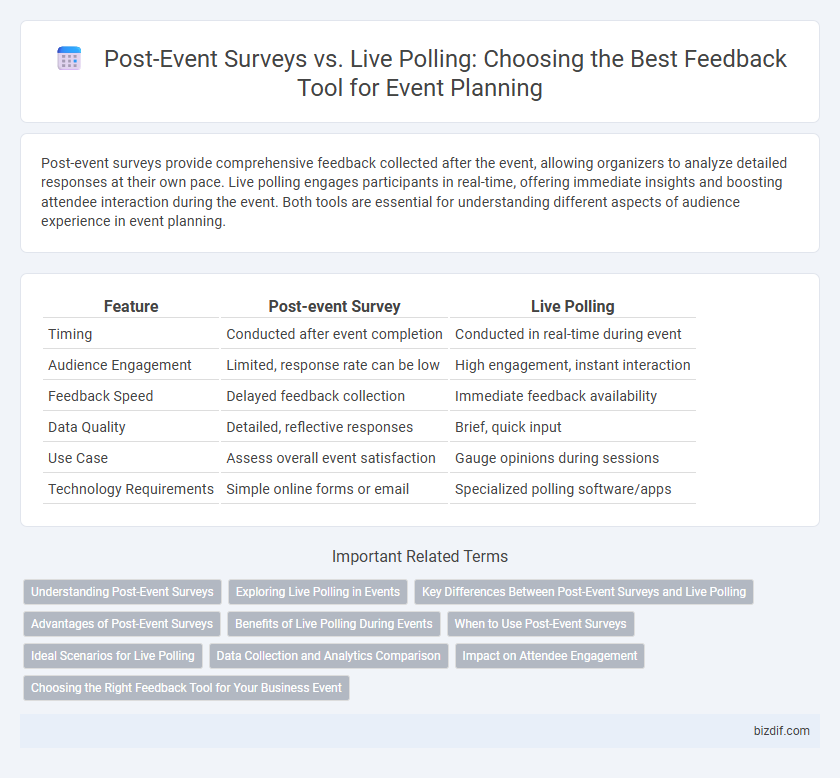Post-event surveys provide comprehensive feedback collected after the event, allowing organizers to analyze detailed responses at their own pace. Live polling engages participants in real-time, offering immediate insights and boosting attendee interaction during the event. Both tools are essential for understanding different aspects of audience experience in event planning.
Table of Comparison
| Feature | Post-event Survey | Live Polling |
|---|---|---|
| Timing | Conducted after event completion | Conducted in real-time during event |
| Audience Engagement | Limited, response rate can be low | High engagement, instant interaction |
| Feedback Speed | Delayed feedback collection | Immediate feedback availability |
| Data Quality | Detailed, reflective responses | Brief, quick input |
| Use Case | Assess overall event satisfaction | Gauge opinions during sessions |
| Technology Requirements | Simple online forms or email | Specialized polling software/apps |
Understanding Post-Event Surveys
Post-event surveys provide comprehensive feedback by allowing attendees to reflect and share detailed opinions after the event concludes, enhancing data accuracy and depth. Unlike live polling, which captures immediate reactions, post-event surveys gather insights on overall satisfaction, event content, and logistical aspects, crucial for improving future events. Analyzing survey responses helps event planners identify strengths, weaknesses, and actionable strategies for event optimization and attendee engagement.
Exploring Live Polling in Events
Live polling in events enhances attendee engagement by providing real-time feedback and interactive participation, which post-event surveys lack due to delayed response collection. Utilizing platforms like Slido or Mentimeter, organizers can instantly gauge audience opinions and adjust event dynamics accordingly. This immediate data capture boosts decision-making efficiency and overall event experience optimization.
Key Differences Between Post-Event Surveys and Live Polling
Post-event surveys gather comprehensive feedback from attendees after the event, allowing detailed analysis of overall satisfaction and specific aspects such as content, logistics, and speaker effectiveness. Live polling captures real-time attendee opinions during the event, fostering engagement and providing immediate insights into participant preferences and understanding. The key difference lies in timing and purpose: post-event surveys focus on reflective, in-depth evaluation, while live polling emphasizes instant interaction and adaptability to audience needs.
Advantages of Post-Event Surveys
Post-event surveys provide comprehensive insights by allowing attendees to reflect on their full experience, resulting in more thoughtful and detailed feedback. They enable organizers to gather quantitative and qualitative data, supporting data-driven improvements for future events. Unlike live polling, post-event surveys offer flexibility in response time, increasing participation rates and overall response quality.
Benefits of Live Polling During Events
Live polling during events enhances real-time audience engagement by enabling instant feedback, which helps organizers adjust the event dynamically. It fosters interactive participation, increasing attendee satisfaction and providing immediate insights into audience preferences and opinions. This real-time data collection allows for more agile decision-making compared to post-event surveys that gather feedback only after the event concludes.
When to Use Post-Event Surveys
Post-event surveys are most effective for gathering comprehensive feedback after attendees have had time to reflect on the event experience. These surveys allow event planners to assess overall satisfaction, identify areas for improvement, and measure long-term impact on participants. Use post-event surveys when detailed, thoughtful responses are needed beyond immediate reactions captured by live polling.
Ideal Scenarios for Live Polling
Live polling excels in scenarios requiring immediate audience feedback and engagement during presentations, workshops, or Q&A sessions. It idealizes environments where real-time data drives dynamic content adjustments and encourages interactive participation. Event planners leverage live polling to boost attendee involvement and gather instant insights that shape ongoing discussions.
Data Collection and Analytics Comparison
Post-event surveys provide comprehensive data collection through detailed feedback, enabling thorough analysis of attendee satisfaction and event impact over time. Live polling captures real-time insights during the event, promoting immediate engagement but offering limited depth for longitudinal analytics. Combining both methods enhances data accuracy and strategic decision-making by balancing immediate participant input with in-depth post-event evaluation.
Impact on Attendee Engagement
Post-event surveys provide detailed feedback enabling organizers to assess overall satisfaction and identify improvement areas, but may suffer from lower response rates due to time gaps. Live polling drives immediate participation during events, boosting real-time interaction and fostering a dynamic attendee experience by capturing instant opinions. Integrating live polling with post-event surveys maximizes engagement analytics, balancing spontaneous input with reflective responses for comprehensive event insights.
Choosing the Right Feedback Tool for Your Business Event
Post-event surveys offer comprehensive insights by collecting detailed responses after an event, making them ideal for in-depth analysis and long-term improvement. Live polling engages attendees in real-time, providing immediate feedback and boosting interaction during presentations or sessions. Selecting the right feedback tool depends on your business event goals, audience size, and the type of data needed to enhance future events effectively.
Post-event survey vs Live polling Infographic

 bizdif.com
bizdif.com